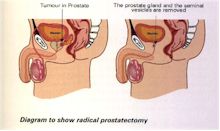|
|
||||||||||||||
|
Prostate cancer surgery |
||||||||||||||
Radical prostatectomy is a major surgical procedure in which the surgeon removes the prostate gland, usually through an incision in the lower abdomen. It is particularly common in the U.S. where 40% are also followed by radiotherapy due to seminal vesicle involvement or incomplete excision margins.
Transurethral resection of the prostate (TURP) is another type of prostatic surgery. This surgical procedure uses a resectoscope (thin, lighted medical instrument with a cutting tool) to remove tissue from the prostate. This is sometimes performed to relieve symptoms caused by tumour before other cancer treatment is given. TURP may also be performed on patients who are not suitable candidates for radical prostatectomy because of their age or general bad health condition. Risks and side effects Surgery, as a prostate cancer treatment option, has several risks and possible side effects. Apart from the general risks that accompany any type of surgery such as anesthesia risks (heart attack, stroke, blood clots), the danger of infections and bleeding during and after the surgery, specific side effects such as urinary incontinence and erectile dysfunction (impotence) are often experienced by patients after the radical prostatectomy. Further general information Your doctors and specialist nurses are in an ideal position to give you relevant information on your disease and treatment as they know your individual circumstances. Cancerbackup has a help line (0808 800 1234) and a prize winning video available in English, Italian, Urdu, Bengali, Gujarati & Hindi explaining Radiotherapy & Chemotherapy. Cancernet.co.uk has over 500 pages describing cancer, its management, practical tips and tool which patients, their carers and their doctors have found helpful during the cancer journey. |
||||||||||||||
 There are three
main types of
radical prostatectomy:
There are three
main types of
radical prostatectomy:



